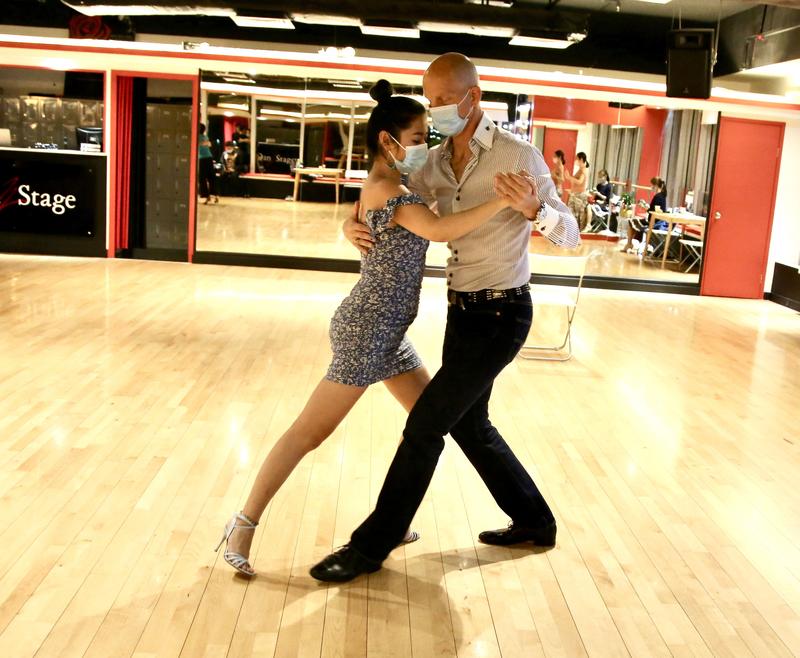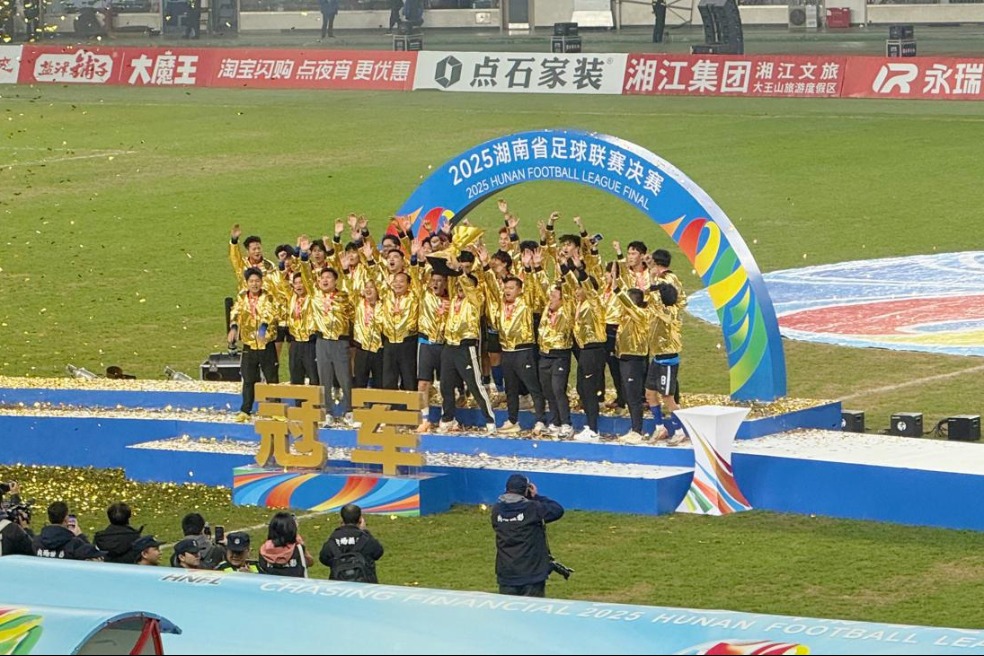One step at a time


Argentine tango dancer Mariela Maldonado strides on stage with confidence. She is wearing a flaming red flowing dress the same color as her lipstick. Her long brown hair is left loose. Maldonado looks every inch the archetype of the tango diva: bold yet sensual and unpredictable. She is joined by her tall, debonair husband, Pablo Sosa. The quartet behind them launches into a thunderous rendition of the 1940s tango anthem Loca (crazy). The pair bursts into moves. Sparks fly. The audience is thrilled, although they are watching only a streamed video, not a live performance.
"We wish we could be there," says Maldonado via a Zoom call from Argentina. She and her husband directed and choreographed besides performing in Tango Legends, recently livestreamed as part of the Dance on Screen show, organized by Hong Kong's Leisure and Cultural Services Department. Tango Legends was planned as a live show in Hong Kong in 2020 but the pandemic forced a rescheduling, possibly to 2022.
Maldonado and Sosa first visited Asia in 2005. They have performed in Singapore, Thailand, South Korea and China where they have been giving lessons.
The reception in China has been mind-blowing. "During performances people jump to their feet and clap," Maldonado says. "People wait for us to sign photos. We feel like stars," says Sosa.
The enthusiasm is also demonstrated in the sheer numbers of students the duo seems to attract in China. "Our classes are (always) full. We have 25 couples (to a class). We have to add more classes constantly," Maldonado says.
They see the Chinese mainland as Asia's focal point for tango. "In Argentina, Buenos Aires is the center of tango, but in China every city is important in its own way; and because of their size, they can be centers of tango," Sosa explains.
Tango Legends features three traditional Argentine dance styles — tango, vals Argentino and milonga, a faster dance with African roots. The music spans compositions from the 1920s to more contemporary ones by Astor Piazzolla, who is himself a virtuoso of the bandoneon, an accordion-like instrument typical of tango ensembles.
"Tango, it's a feeling. You can feel your partner's heartbeat while dancing in a close embrace. It's a three-minute love story," says Sosa with a twinkle in his eye.
Local champs
Watching the live-stream are Hong Kong's premier Argentine tango teachers and performers, Lily Cheng and Raymond Chu. The pair helped put Hong Kong on the world map of tango, first by winning the Tango Dance Asian Championship in 2011 and later the Tango World Championship in China in 2014 as well as representing Hong Kong in the Mundial de Tango in Buenos Aires in 2011.
"Many dancers seek out our students in festivals because they enjoy dancing with them," Cheng says proudly.
While several dance venues in Hong Kong were forced to shut down because of the pandemic, Cheng and Chu's tango school has grown in size. They recently moved to a new dance studio with a bigger floor. However, COVID-19 did impact the school's normal functioning, especially during the periods when social distancing was being observed most astutely in the city.
"The pandemic made our students stop dancing, but it also made them understand the importance of human contact," say Cheng and Chu. The challenges posed by COVID-19 were particularly acute for tango dancers, as "the eagerness of sharing and communication between real people is always the inevitable attraction of Argentine tango."
A COVID-19 outbreak among a section of Hong Kong's ballroom dancers in November 2020 was a major setback. "We were criticized and discriminated against by some of our studio neighbors. Sixty percent of the students stopped coming," Chu says, adding that no one from their school or the Hong Kong tango community had COVID-19.
When dance schools had to shut their doors, dancers like Barry Tam went online. Tam began taking private tango lessons via Zoom from the Paris-based Argentine tango masters, Sebastian Misse and Andrea Reyero.
"It turned out good, beyond my expectation," says Tam who uses two computers to capture his movements during each Zoom session. "My teachers are able to spot the mistakes on Zoom through two cameras set at opposite corners of the room."
He also reveals that Zoom classes are more affordable for dancers unable to travel abroad from Hong Kong or invite teachers to the city. Then it's also limiting, particularly for male dancers, since it's the male partner who leads in tango, making it necessary for them to pick up the techniques first hand.
Masked balls are back
Argentine tango has been danced in Hong Kong since 1995 and its following expanded around the year 2000 with the founding of the TangoTang club. Ray Rudowski, a former TangoTang president, says at one time they had more than 300 active dancers on their rolls.
Even after the club folded in 2017, and until COVID-19 struck, Hong Kong had a lively tango scene with dance parties, called milongas, held in the evenings. Tango events, including shows, festivals, workshops with visiting teachers and even competitions would be held regularly. To keep the tango scene active during the frequent bans on indoor gatherings triggered by periodic surges of COVID-19 cases in the city, Rudowksi started a podcast series exploring the history and culture of Argentine tango, featuring interviews with dance personalities from around the world including Hong Kong.
Now that the restrictions have been relaxed, Rudowski organizes a weekly practice group and monthly gathering he playfully calls Milonga Mascarita.
"Mascarita in Spanish means a woman at a masquerade ball. So I thought the name had both cultural significance and highlighted the need to wear a mask during the event, at least for the time being," he explains.
"Argentine tango's appeal is both sensual and subversive and perhaps that's one reason it attracts a small but very dedicated, even fanatical, following," Rudowski adds.
He explains that Argentine tango has its roots in the culture of the poor working-class immigrants who came to Argentina in the late 19th and early 20th centuries. It was shunned by the Catholic Church before gaining respectability and becoming a cultural phenomenon in the 1930s and '40s, only to be replaced by other musical art forms like rock 'n' roll.
"Many of the lyrics to tango songs dating back to the 1930s and '40s showcase tango's unique struggle for cultural survival, relevancy and maintaining its uniquely Argentine identity," he says. The pandemic is perhaps only the latest of the many challenges Argentine tango has faced throughout its more than 120-year history.
In April, local teachers Cheng and Chu were the first to give a public performance since the pandemic began in Hong Kong early in 2020. The pair was featured at Hong Kong Philharmonic Orchestra's Piazzolla at 100 concert, marking the centenary of the Argentine composer and bandoneon virtuoso. The Argentine guest conductor Mariano Chiacchiarini underwent a three-week quarantine after flying into Hong Kong especially for this concert.
And it's only a matter of time before Maldonado and Sosa make their next Hong Kong trip. "We will go to Hong Kong after the pandemic. It will be soon!" they assure their Hong Kong audience from the virtual space.
- China says Philippines hands over kidnapping, murder suspect
- Mainland says PLA drills warn Taiwan independence forces, foreign backers
- British writer donates family's archives to Peking Union Medical College Hospital
- Taiwan separatist forces are heading for a 'dead end', expert says
- A suspect involved in kidnapping and murdering Chinese citizens extradited to China
- Shandong connects 1,000 MW offshore solar project to the grid





































